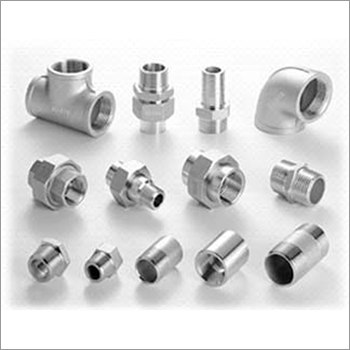Top Supplier Of Stainless Steel Fittings In Saudi Arabia Is Shree Viratra Enterprises.
Welcome to Shree Viratra Enterprises, your premier destination for high-quality stainless steel fittings in the UAE. As manufacturers, stockists, and suppliers, we offer a comprehensive range of stainless steel fittings to meet your diverse needs. Please browse our inventory and experience excellence in every fitting.
Stainless steel fittings, categorized under HS Code 7307, form the backbone of piping systems in diverse industries. Comprising primarily stainless steel, an alloy containing a minimum of 10.5% chromium, these fittings benefit from creating a protective oxide layer that shields against corrosion. This corrosion resistance is vital in environments prone to harsh conditions, such as chemical processing plants, marine installations, and outdoor setups.
Benefits of Stainless Steel Fittings:


The utilization of stainless steel fittings brings about numerous advantages across various industries:
1. Corrosion Resistance: Stainless steel fittings exhibit exceptional resistance to corrosion, rust, and staining, making them well-suited for use in aggressive environments where exposure to corrosive substances is prevalent.
2. Durability and Longevity: Renowned for their outstanding durability, stainless steel fittings boast an extended lifespan, even when subjected to extreme temperatures, high pressures, and abrasive materials. This durability reduces downtime and replacement costs, contributing to overall operational efficiency.
3. Hygienic Properties: Stainless steel’s inherent hygienic properties make it an ideal choice for food and beverage processing, pharmaceuticals, and healthcare industries. The smooth surface of stainless steel fittings impedes bacterial growth, facilitates easy cleaning and sterilization, and ensures product purity and safety.
4. Strength and Toughness: Stainless steel fittings are characterized by high strength and toughness, enabling them to withstand heavy loads, impacts, and mechanical stresses without succumbing to deformation or failure. This robustness renders them suitable for structural applications and high-pressure piping systems.
5. Aesthetic Appeal: Apart from their functional attributes, stainless steel fittings lend a sleek and modern aesthetic to architectural, interior design, and decorative applications. Available in various finishes, including polished, brushed, and matte, they offer versatility to complement diverse design styles and preferences.
6. Temperature Resistance: Stainless steel fittings demonstrate exceptional resistance to temperature extremes, ranging from cryogenic temperatures to elevated temperatures encountered in industrial processes. This thermal resilience renders them suitable for refrigeration systems, heat exchangers, and thermal power plants.
7. Environmental Sustainability: Stainless steel, a recyclable material with a high scrap value, underscores the environmental sustainability of stainless steel fittings. By opting for stainless steel fittings, industries can minimize their ecological footprint, conserve natural resources, and contribute to a circular economy.
Stainless steel fittings come in various types, each serving specific functions within piping systems:
– Stainless Steel Elbows: These fittings facilitate changes in the direction of piping systems and are available at different angles, such as 45 degrees, 90 degrees, and 180 degrees.
– Stainless Steel Tees: Tees feature three openings and are utilized to combine or split fluid flow in piping systems. There are options for equal tee configurations or reducing tees.
– Stainless Steel Reducers: Reducers are employed to connect pipes or tubes of varying sizes and can have either concentric or eccentric designs based on the alignment of the centerlines of the pipes.
– Stainless Steel Couplings and Union Fittings: Couplings connect two pipes or tubes of the same size and are frequently used in repair or maintenance applications. Similar to couplings, units allow for easy disassembly of connected pipes or tubes and consist of male and female ends joined by a nut.
– Stainless Steel Flanges: Flanges connect pipes or tubes to other components such as valves, pumps, or tanks, facilitating the assembly and disassembly of piping systems.
– Stainless Steel Valve: Valves regulate or control fluid flow within piping systems and encompass various types, including ball valves, gate valves, globe valves, butterfly valves, and check valves.
– Stainless Steel Adapters: Adapters connect pipes or tubes of different materials or connection types, including threaded, weld, or compression adapters.
Applications of Stainless Steel Fittings:
The versatility and resilience of stainless steel fittings render them indispensable across a multitude of industries and applications, including:
– Chemical Processing: Stainless steel fittings are pivotal in chemical plants, facilitating safely and efficiently handling corrosive chemicals and fluids within piping systems.
– Oil and Gas Industry: In oil refineries, offshore platforms, and pipelines, stainless steel fittings are crucial for withstanding the harsh conditions inherent in oil and gas extraction, refining, and transportation.
– Food and Beverage Processing: The hygienic properties and corrosion resistance of stainless steel fittings make them indispensable in food and beverage processing plants, ensuring the purity and safety of transported products.
– Pharmaceutical Industry: Stainless steel fittings are utilized in pharmaceutical manufacturing facilities to transport pharmaceutical ingredients, chemicals, and fluids in compliance with stringent regulatory standards, safeguarding product integrity and sterility.
– Water Treatment: Stainless steel fittings are instrumental in water treatment plants for treating and distributing potable water, wastewater, and industrial water, withstanding the corrosive effects of water and chemicals.
– Construction and Infrastructure: In construction and infrastructure projects, stainless steel fittings find application in plumbing, HVAC systems, and structural components, providing reliable connections and contributing to the longevity of buildings and structures.
– Marine and Offshore Applications: Due to their corrosion resistance, stainless steel fittings are widely employed in marine and offshore applications such as shipbuilding, offshore platforms, and marine structures, where they endure exposure to saltwater and harsh environmental conditions.
– Agriculture and Irrigation: In agricultural settings, stainless steel fittings are utilized in irrigation systems, agricultural machinery, and livestock facilities. They ensure efficient water distribution and resistance to corrosion from fertilizers and pesticides.
– Automotive and Transportation: Stainless steel fittings are integral to automotive manufacturing, transportation infrastructure, and vehicle components, offering durability, corrosion resistance, and reliability in demanding automotive environments.
Common Grades of Stainless Steel Used in Fittings:
1. 304 Stainless Steel: Comprising 18% chromium and 8% nickel, 304 stainless steel offers good corrosion resistance and is widely used in food processing equipment, kitchen appliances, and architectural components.
2. 316 Stainless Steel: With 16-18% chromium, 10-14% nickel, and 2-3% molybdenum, 316 stainless steel provides superior corrosion resistance and finds application in marine equipment, chemical processing, and medical devices.
3. 316L Stainless Steel: A low-carbon variation of 316 stainless steel, 316L offers improved weldability and resistance to corrosion in welded structures, making it ideal for sanitary applications in pharmaceutical and food processing industries.
4. 321 Stainless Steel: Containing 17-19% chromium, 9-12% nickel, and titanium, 321 stainless steel exhibits excellent resistance to intergranular corrosion and high temperatures, suitable for aerospace, automotive, and furnace applications.
5. 347 Stainless Steel: Similar to 321 stainless steel but with the addition of niobium, 347 stainless steel provides enhanced resistance to intergranular corrosion and high-temperature oxidation, making it suitable for high-temperature applications such as chemical processing, aerospace, and furnace components where durability and stability are paramount.
6. Duplex Stainless Steel (e.g., 2205, 2507): Featuring a balanced mix of austenite and ferrite phases, duplex stainless steel boasts high chromium and molybdenum content. It offers superior strength, corrosion resistance, and stress corrosion cracking resistance compared to austenitic stainless steel. Its weldability and toughness are ideal for aggressive environments such as offshore oil and gas platforms, desalination plants, and chemical processing equipment.
7. 904L Stainless Steel: Characterized by high levels of chromium, nickel, and molybdenum, along with added copper, 904L stainless steel provides exceptional resistance to sulfuric acid and other aggressive environments, including chloride-induced stress corrosion cracking. Its good formability and weldability render it suitable for applications in chemical processing, pharmaceuticals, seawater handling equipment, and petrochemical industries.
8. Alloy 20 (UNS N08020): Comprising a nickel-iron-chromium alloy with additions of copper and molybdenum, Alloy 20 offers excellent resistance to sulfuric acid and other corrosive environments, including pitting and crevice corrosion. With its good mechanical properties and fabricability, Alloy 20 finds extensive use in chemical processing, pharmaceuticals, food processing, and marine applications where resistance to corrosive chemicals is imperative.
Stainless steel fittings stand as indispensable components in various industrial and commercial applications, underpinning piping systems’ functionality, reliability, and longevity worldwide. From unparalleled corrosion resistance and durability to their hygienic properties and aesthetic appeal, stainless steel fittings enhance performance, safety, and sustainability across diverse industries.

